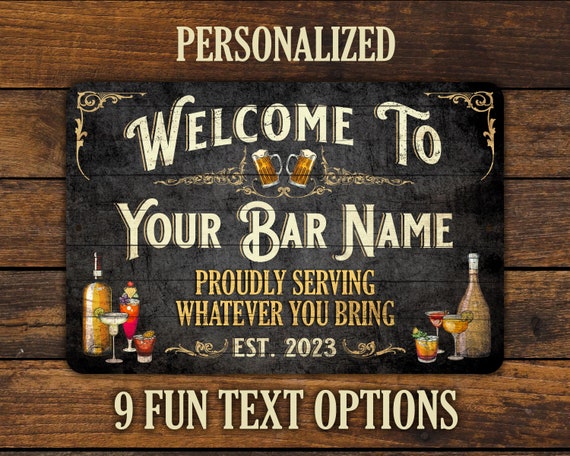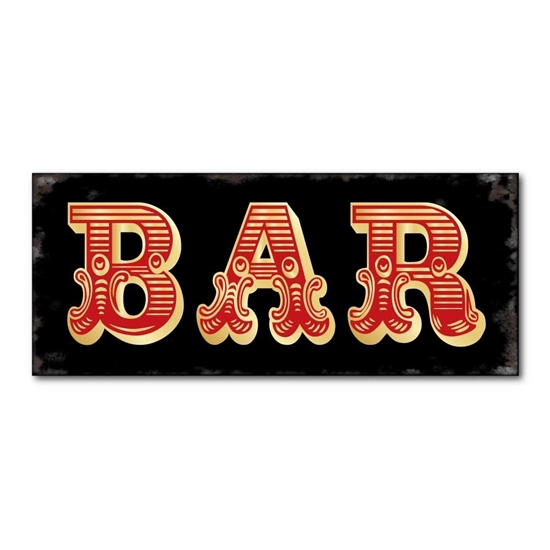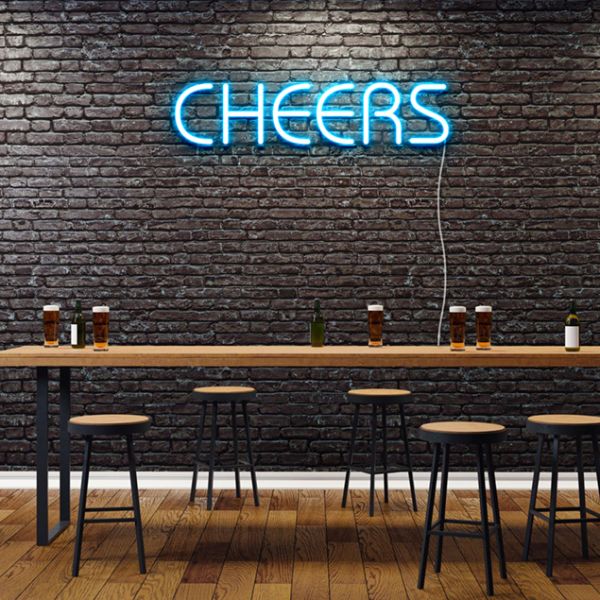Handy Reasons On Deciding On Pub Signs
Wiki Article
How Do Bar Signs Are Designed And Styled Differently?
Bar signs are designed and styled in different ways to reflect the ambience of the bar and the target market for it. Here are the main styles and design variations: 1. Vintage/Retro
The characteristics of classic, vintage items include their distressed, weathered, or nostalgic appearance.
Design Elements: Use of vintage fonts, old metal or wood, old-fashioned logos, and old-fashioned graphics.
Uses: Suitable for bars that have themes of nostalgia like speakeasies, pubs and traditional American diners.
2. Modern
Characteristics: Sleek, clean, minimalist.
Design Elements: Bold or monochromatic geometric patterns with bold colors. Most often, they are made of metal or acrylic.
Uses for this product This product is ideal for modern bars.
3. Rustic
Characteristics: Natural, earthy and comfortable.
Design elements Using reclaimed timber, hand-painted, or carved lettering and natural colors.
Uses : Perfect for restaurants that serve food from the farm to table and mountain lodges.
4. Industrial
Characteristics: Raw, unfinished, edgy.
Design Elements: Exposed metal pipes, reclaimed material as well as neutral tones and bold fonts.
Uses: Perfect for bars and lofts in urban settings Warehouses that have been converted, as well as lofts.
5. Glamorous
Characteristics: Elegant, luxurious, eye-catching.
Design Elements: Use of silver, gold, and other metals, sparkle, ornate fonts, and sophisticated graphics.
Uses: Great for bars or clubs as well as other places that cater to a high end clientele.
6. Nautical
Characteristics : Coastal marine and adventure.
Design Elements: Anchors and ships as nautical symbols, blue-and-white color schemes and rope and wooden textures.
Uses: Great for waterfront establishments such as beach bars and restaurants.
7. Tropical
Characteristics: Bright, colorful, relaxed.
Design Elements : Vibrant colors and images of palm trees and tropical plants, fonts that seem playful, as well as images of the beach.
Uses: Ideal for tiki bars, beach clubs, island-themed establishments.
8. Sports
Characteristics: Energetic, team-oriented, spirited.
Design elements Design elements include team logos or sports imagery. Bold colors. Fonts that are dynamic.
Applications: Perfect for pubs and sports bars catering to those who love sports.
9. Steampunk
Characteristics: Futuristic, Victorian, mechanical.
Design Elements: Gears and cogs. Brass, leather and texture textures. Antique fonts.
Uses: Great for themed bars that mix the best of both worlds.
10. Art Deco
Characteristics: Glamorous, geometric, bold.
Design Elements Geometric patterns and dark and gold colors, symmetrical design, elegant fonts.
It is a great choice for bars looking to recreate a Gatsby 1920s style.
11. Humorous/Quirky
Characteristics: Fun, light-hearted, engaging.
Design Features: Cartoon graphics, funny slogans and fun fonts.
Uses: Perfect for casual bars, dive bars and other places that wish to create a relaxing and enjoyable ambience.
12. Traditional Pub
Characteristics: Warm, inviting, classic.
Dark woods, traditional fonts, symbols of heraldry, and pub imagery are all design elements.
Applications The product is an excellent product for British and Irish pubs as well as establishments with an old-fashioned European feel.
13. Western
Characteristics: Rustic, rugged, cowboy-themed.
Design elements: Wooden textures, cowboy images, rope fonts, and earthy tones.
Uses: Perfect for bars that have a western theme, BBQ joints and country music venues.
14. Neon
Specifications: Bright, vibrant and attention-grabbing.
Design Elements : Neon light with different colors, and sometimes simple graphic elements and fonts.
Uses: Great for trendy bars, clubs and other establishments that wish to create a vibrant, energetic atmosphere.
15. Minimalist
Characteristics: Simple, clean, understated.
Design Elements: Monochromatic or limited color schemes. Sleek fonts.
Uses Ideal for modern bar with a flair to have a chic and elegant style.
When choosing the appropriate design bar owners can create a uniform look and feel that will enhance customers' experience as well as the overall atmosphere. Take a look at the recommended updated blog post for website examples including large pub sign, personalised cocktail sign, design your own bar sign, pub sign hanging, the staying inn sign, pub bar signs for sale, pub signs personalised, novelty bar signs, the pub sign, the staying inn pub sign and more.

How Are Bar Signs Different When It Comes To Mounting And Setting Up?
Installation and mounting methods for bar signs differ based on factors such as their dimensions, type and size and the place of the sign and its intended purpose. This article will give an in-depth look at the different mounting and installation alternatives for bar sign. Wall-Mounted Signs
Attached directly to walls.
Methods:
Screws & Anchors: Often employed on signs that are heavier (metal and wood) to ensure stability.
Adhesive Strips: Ideal for signs that are lighter (foam board and acrylic) and temporary installations.
Brackets are used to help make signs visible by allowing them to extend out from the wall.
Uses: Indoor decor, menu boards, directional signs.
Benefits: A secure and versatile display.
The disadvantages of this product include: It could damage walls and can be difficult to position.
2. Hanging Signs
Suspended from ceilings and overhangs.
Methods:
Chains: Strong and flexible perfect for large signs.
Cables: Modern designs typically make use of cables to give them a sleeker appearance.
Rods: Provide a rigid support structure.
Uses: Ceiling decor, directional signs, overhead promotional signs.
Vertical space is extremely visible, and the options for decoration are limitless.
Negatives
3. Freestanding Signs
Specifications of the product: The stand is not connected to anything.
Methods:
A-Frame: Foldable and mobile, commonly used for advertising on sidewalks.
Pedestal Stands: Stable base, ideal for indoor use.
Post and Panels: Usually employed for longer-lasting, more substantial signs.
Uses: Outdoor advertising, indoor directional signs, promotional displays.
The lightweight and flexible design allows for easy adjustment.
The downside is that it can be bulky. It also requires plenty of area for floor.
4. Window Signs
The characteristics of the windows are directly attached to them.
Methods:
Suction cups are easy to put in, remove and use for smaller signs.
Adhesive vinyl is ideal for decals and graphics, it is able to be directly applied on glass.
Static Cling - Non-permanent. Reusable. It is easy to apply and remove.
Uses: Promoting message, branding, and operating hours.
Benefits: The most windows and highly visible from outside.
Limitations: May be in the way of sunlight, but is and is limited by the dimensions of the window.
5. Backlit and Edge-Lit Signs
Specifications: Incorporate lighting into the sign's structure.
Methods:
Wall Installation with Electrical Connections It requires a secure attachment and electrical hook-ups.
Suspended by Power Cables Combines hanging technique with integrated lighting.
Uses: High-visibility branding, menu boards as well as decorative elements.
Advantages: Increased visibility and attractive lighting.
Negatives
6. Temporary and Portable Signs
Features Designed to be rapid and simple set-up.
Methods:
Pop-up Stands: Lightweight and compact.
Banner Stands: Roll-up or retractable designs.
Applications: Promotions, events and seasonal decor.
Benefits: Fast and simple set-up, easy to transport.
Negatives
7. Magnetic Signs
Specifications: Magnetic force is used for attachment.
Methods:
Magnet Strips: Stick to the back of the sign.
Magnetic Boards: Signs attach to a metallic surface.
Uses : Menu boards that are updated, as well as notices for temporary use.
Advantages: Easy to change, no permanent fixtures required.
Pros Magnetic surfaces aren't as strong and may cause less security.
8. Projection Signs
Make use of light to show a text or image.
Methods:
Projectors mounted: They can be easily hung on walls or ceilings.
Portable projectors can be placed on a stand or a surface.
Applications: Dynamic displays promotions, events.
Features: It is easy to modify content. There is no requirement for signs on the ground.
Advantages: Needs an environment that is controlled for lighting dependent on the quality of the projector.
Things to consider when mounting and installing
Size and Weight
Heavy Signs: You need more durable mounting solutions such as anchors and screws.
Light Signs: You can use more simple methods, such as adhesive strips or suction cups.
Durability
Permanent Signs: Choose an extra secure and long-lasting method of mounting.
Temporary signage: Use methods that allow you to move and relocate the sign.
Location
Indoor: Greater flexibility in terms of materials and methods, with less worry about weather.
Outdoor: Needs weather-resistant material and secure mounting that can be able to withstand the elements.
Aesthetics
Concealed mounting: This method provides a cleaner look by hiding the hardware.
The decorative hardware can enhance the appearance of the sign.
Accessibility
Quick Access to Changes for Easy Access Easy Access for Changes: This is crucial for signs, such as menu boards, which require frequent updating.
Security: Ensures your signs aren't easily tampered with or snatched.
By considering these factors Bar owners can pick the right mounting and installation techniques that meet their specific needs, ensuring the security of their signage, visible, and in line with their bar's aesthetic and functional requirements. Check out the best home pub signs for more tips including home garden bar signs, personalised metal bar signs, make your own bar sign, personalised hanging bar sign, to the bar sign, personalised cocktail sign, cocktail bar sign, bar hanging sign, home made bar sign, bar pub signs and more.

How Are Bar Signs Maintained Differently?
The upkeep of bar signs is affected by various factors, including the location, design and the material. How bar signs differ in maintenance. Material
Metal Signs: Most require little maintenance, however cleaning may be required to get rid of dirt.
Wood Signs: They need to be inspected regularly to check for signs of warping and rot. They may also require staining and sealing frequently to maintain their appearance.
Acrylic signs are easy to clean using water and soap. Resistant to most chemicals and scratches.
Neon/LED sign: requires periodic bulb replacement and examination of electrical components.
2. Lighting
Non-Illuminated Signals: They are usually low-maintenance. A periodic clean might be required to get rid of dust or dirt.
Illuminated Signs with LEDs periodic inspections are required of all lighting components (such as bulbs or LED modules), and cleaning or lens or diffuser to ensure their visibility.
3. Location
Indoor Signs require less maintenance as they are better protected from the environment.
Outdoor signs require more frequent upkeep due to the exposure to UV radiation, weather conditions and changes in temperature. It is possible to cover the sign with protective coatings or conduct regular inspections in order to avoid deterioration.
4. Design Complexity
Simple Signs: Simple designs that have fewer parts require less maintenance than complicated or complex designs that may contain more areas that are susceptible to damage or dirt.
Digital Signs (Digital Displays): These signs require regular software updates and content changes and also technical maintenance to function properly.
5. Installation and Mounting
Secure Mounting: Signs that are correctly mounted will require less maintenance as they will not shift or become loose as time passes.
Signs with poor mounting: Signs that have been poorly mounted or have been placed in a poor location may require frequent maintenance due to issues such as sagging, tilting or the detachment.
6. Environmental Factors
Weather Exposure: Signs that are visible in regions with high humidity, that have extreme temperatures or precipitation might require regular maintenance. This is to prevent corrosion or fading.
Pollution and debris Signs that are located in industrial and urban areas can accumulate more dust, dirt or pollution, requiring regular maintenance to keep them in good condition and appearance.
7. Customization
Custom Signs - Signs that have complex designs, custom finishes or unique features require special care and maintenance to ensure their appearance and functionality.
8. Frequency
Regular Maintenance. Establishing a schedule for routine cleanings, inspections and maintenance will prevent minor issues from growing into. This will ensure that your signage are in top condition.
Maintenance as Needed Signs will require further maintenance to address issues such as damages and malfunctions or wear.
A well-maintained home can provide you with many advantages
Extended Lifespan. Regular maintenance is a great way to prolong the life span of your signage and reduce the need for premature replacement.
Optimal performance: Signs which are well maintained keep their visibility, their accessibility and the effectiveness of conveying messages to customers.
Cost savings - Preventative maintenance will save you money by avoiding expensive repairs.
Understanding the requirements for maintenance associated with different types of bar signs, and by creating a proactive plan for maintenance, bar owners can ensure that their signage is stylish, functional and effective in enhancing the overall ambiance and customer experience. See the recommended here for hanging bar sign for website tips including bespoke bar signs, personalised outdoor bar signs, personalised sign for bar, personalised home bar signs, outdoor personalised bar sign, outdoor personalised bar sign, to the bar sign, bar wall signs, personalised signs for home bar, bar signs for home bar and more.
